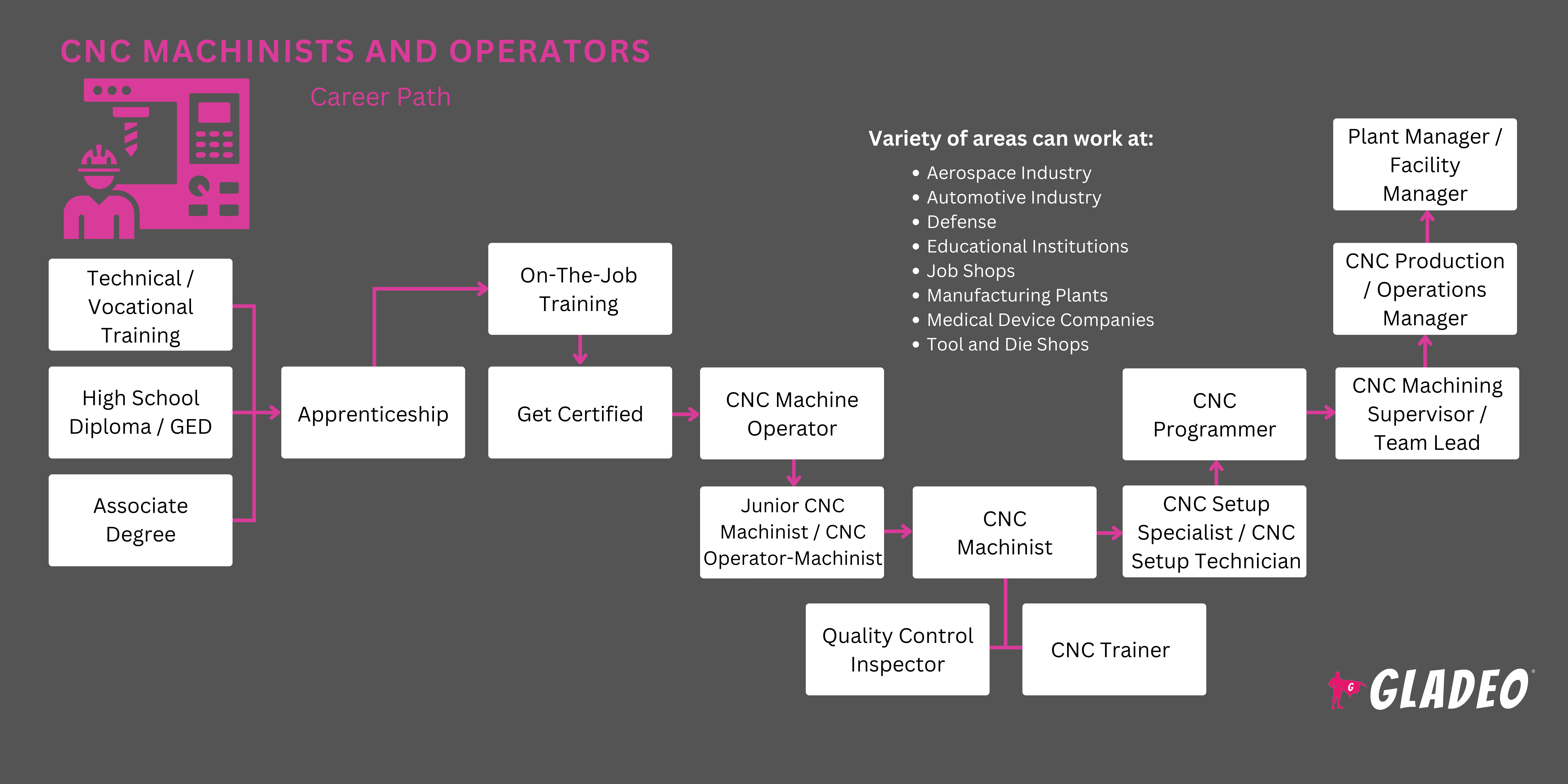스포트라이트
CNC 기계공(컴퓨터 수치 제어 기계공), CNC 기계공(컴퓨터 수치 제어 기계공), 기어 기계공, 기계 수리 담당자, 기계공, 유지 보수 기계공, 수동 선반 기계공, 생산 기계공, 공구실 기계공
현대 사회는 크고 작은 제품을 사랑합니다. 자동차부터 컴퓨터까지, 우리는 제조된 제품 없이는 살아갈 수 없습니다. 그리고 CNC 기계공과 작업자가 없었다면 우리가 자주 사용하고 의존하는 제품의 대부분은 존재하지 않았을 것입니다. 이 숙련된 기술자들은 다양한 컴퓨터 수치 제어(CNC) 기계와 장비를 사용하여 다양한 정밀 금속 부품을 생산합니다.
기계공과 오퍼레이터의 업무는 비슷하지만 기계공이 더 많은 경험을 가지고 있으며 오퍼레이터를 감독할 수도 있습니다. 이들은 작업 중인 CNC 기계에 지시를 입력하여 필요에 따라 부품이 절단되고 제작되도록 합니다. 특정 부품을 반복해서 생산하거나 매일 일괄적으로 만들어야 하는 부품 세트가 있을 수 있습니다. 경우에 따라서는 고장난 부품을 수리하거나 교체하는 일을 하기도 합니다.
CNC 기계는 작업하기에 매우 위험할 수 있으므로 CNC 기공사와 작업자는 적절한 사용법에 대해 고도로 훈련받아야 합니다. 이러한 기계를 사용하는 것 외에도 기계공과 작업자는 작업 시 레이저와 전선을 사용할 수 있으므로 위험은 더욱 커집니다! 따라서 안전 프로토콜을 엄격하게 준수하는 것이 더욱 중요합니다. 또한 이 직종에 종사하는 대부분의 직원이 학업 과정과 감독을 받는 견습 과정을 병행하여 기술을 배우는 이유이기도 합니다.
- 꼭 필요한 제품을 완성하는 데 필수적인 부품 제작
- 거의 모든 산업에서 사용되는 부품을 안정적으로 공급하여 경제 전반에 기여합니다.
- 고객 대면 업무나 관리 감독을 많이 받는 직무를 선호하지 않는 분들을 위한 충분한 독립성 보장
근무 일정
CNC 기계공 및 운영자는 풀타임으로 근무하며 목표와 기간에 따라 초과 근무가 필요할 수 있습니다. 이들의 업무는 일반적으로 공장이나 상점의 실내에서 수행되지만, 현장 수리를 위해 여러 장소를 이동해야 할 수도 있습니다.
일반적인 의무
- 최종 제품의 요구 사항과 원하는 수량으로 생산하기 위한 비용에 대해 논의합니다.
- 참조 파일(청사진, 도면 등)과 제작하고자 하는 부품 및 품목에 대한 설명 및 사양을 검토합니다.
- 새 작업 스케치 만들기
- 시작하기 전에 작업 프로세스의 순서를 결정하세요.
- 측정기를 사용하여 최종 제작 부품의 치수를 결정합니다.
- 가공할 재료의 공차 확인
- 필요에 따라 CAD(컴퓨터 지원 설계) 및 CAM(컴퓨터 지원 제조) 프로그램 사용
- 정밀 부품을 제작하거나 가공하기 위해 컴퓨터 수치 제어(CNC) 공작 기계를 설정, 프로그래밍 및 작동합니다.
- 프로그램 업데이트가 CNC 기계와 호환되는지 확인
- 절삭날, 고정 장치 등 CNC 기계의 다양한 구성 요소를 조정합니다.
- 지정된 공작물을 만드는 데 사용할 블랭크 유형을 결정합니다.
- 절단할 금속 스톡에 표시
- 필수 개인 보호 장비를 착용하고 정해진 안전 수칙을 준수하세요.
- CNC 기계 이송 및 속도를 주시하세요.
- 선삭, 밀링, 드릴링, 성형, 연삭 등의 공정을 사용하여 부품을 제작합니다.
- 절단 후 품목의 결함 및 품질을 검사합니다. 필요한 경우 기계를 조정합니다.
- 기계 오류를 진단하고 경미한 수리를 수행합니다. 필요에 따라 분해
- 완성된 제품이 요구 사항을 준수하는지 확인
- 작업 공간에서 폐기물을 제거하고 적절하게 재활용하거나 폐기하세요.
추가 책임
- 기술 매뉴얼에 대한 최신 정보 확인
- 신규 CNC 기계공 및 운영자, 기술자 및 기술자 교육 및 멘토링
- 작업 공간을 청결하게 유지하고 기계에 대한 정기적인 유지보수 수행
- 담당자와 기술적 문제를 논의하세요.
- 프로젝트 계획 단계에서 요청이 있을 경우 조언 제공
소프트 스킬
- 경보
- 분석
- 주의
- 규정 준수 지향
- 비판적 사고
- 디테일 지향
- 징계
- 끈기
- 계획 및 구성
- 문제 해결 능력
- 건전한 판단
- 체력
- 팀워크
- 시간 관리
기술 능력
- 암체어 기공사 및 기공사 계산기와 같은 기공사 프로그램
- Autodesk AutoCAD, CATIA, PTC Creo Parametric, SolidCAM과 같은 컴퓨터 지원 설계 프로그램
- 오토데스크 퓨전 360 및 CNC 마스터캠과 같은 컴퓨터 지원 제조 소프트웨어
- 산업용 제어 소프트웨어(예: 편집CNC 또는 마작 마자트롤)
- 헥사곤 메트롤로지 PC-DMIS와 같은 절차 관리 프로그램
- 마이크로미터, 버니어 캘리퍼스, 선반, 밀링 머신, 셰이퍼 및 그라인더, 드릴링 머신, 절삭 공구, 레이저 및 워터젯과 같은 도구 및 장비에 익숙해야 합니다.
- 금속 가공, 브레이징, 열처리 및 용접과 같은 공정에 익숙해야 합니다.
- 유압 시스템, 전기 배선, 윤활유 및 배터리에 대한 지식이 있어야 합니다.
- 강철, 황동, 알루미늄, 구리, 아연, 납, 바나듐, 망간을 포함한 다양한 유형의 금속 및 금속 합금에 대한 친숙함
- 고용 서비스
- 기계 제조
- 기계 공장
- 운송 장비 제조
CNC 기계공과 작업자는 매우 구체적인 요구 사항을 준수하는 제품을 대량 생산하는 데 의존합니다. 따라서 마감 기한을 맞춰야 한다는 압박감 속에서도 세심하게 작업해야 합니다. 어떤 금속을 사용할지, 어떻게 가장 잘 자르거나 모양을 만들지 등 여러 가지 요소를 고려해야 합니다. 공장은 시끄럽고 위험할 수 있으므로 작업자는 고글이나 청력 보호구와 같은 보호 장비를 착용해야 합니다.
이들은 자신이나 다른 사람이 다치지 않도록 안전 절차를 주의 깊게 따라야 합니다. 일상적인 작업은 작업자가 보통 구부리거나 기대는 자세로 서 있기 때문에 많은 체력이 필요합니다. 부품 가공의 반복은 시간이 지나면 단조로워질 수 있지만, 작업의 내재된 위험 때문에 작업자는 집중력을 유지해야 합니다. 혼자 일하는 시간이 길어질 수 있기 때문에 기계공은 때때로 직장을 벗어나 사교 활동을 해야 할 때도 있습니다.
업계의 미래를 형성하는 많은 CNC 기계 트렌드가 있습니다. 그중 하나는 더 빠른 스핀들 속도, 더 빠른 이송 용량, 더 빠른 컴퓨팅, 더 빠른 공구 교환 등 더 빠른 속도를 구현할 수 있는 기계의 개발입니다. 이러한 속도 향상으로 인해 정밀도가 떨어지지 않는 이유는 CNC 기계가 동시에 더 정확해지고 있기 때문입니다!
이러한 발전과 함께 3D 프린팅은 CNC 기계가 마무리하는 부품을 만들기 위해 일부 작업 부하를 분담하기 시작했습니다. 또 다른 변화는 "가공 과정에서 발생할 수 있는 돌발 상황을 줄이거나 제거"하기 위해 "작업 현장의 설정을 포함한 CNC 기계와 그 환경을 CAM 소프트웨어 내에 복제하여 정확한 공구 경로 시뮬레이션을 제공하는" 디지털 트윈의 사용입니다.
기계 관련 직종에 종사하는 사람들은 보통 손으로 작업하는 것을 좋아하고 공구와 고정식 중장비를 사용하는 것을 편안하게 느낍니다. 고등학교 때 수학과 컴퓨터 프로그래밍 과정을 즐겼거나 실습 수업에서 프로젝트를 수행하는 것을 좋아했을 수도 있습니다.
기계공은 다른 사람과 협업할 수 있지만 장시간 혼자 있어도 괜찮습니다. 이들은 자라면서 매우 독립적이었고 다른 사람과 많은 상호작용 없이 자유롭게 일할 수 있는 직업을 항상 원했을 수 있습니다.
필요한 교육
- CNC 기계공 및 운영자는 고등학교 졸업장 또는 검정고시 이상의 학력이 필요합니다.
- 이 분야의 많은 근로자는 전문대학이나 기술학교에서 자격증 또는 준학사 학위를 취득하여 수학 능력을 연마하고 청사진 읽기, 금속 작업, 수공구 및 CAD 또는 CAM 프로그램 사용, CNC 기계 작동 방법을 배웁니다.
- 기타 일반적인 과정은 다음과 같습니다:
- 기하학적 치수 측정 및 허용 오차
- 다축 밀링 및 터닝
- 정밀 측정
- 프로그래밍
- 매장 안전
- 입사 지원 전에 정식 교육 수업을 듣는 것은 필수는 아니지만, 구직 과정에서 경쟁력을 높이는 데 도움이 될 수 있습니다.
- 더 많은 자격증을 보유한 지원자는 실무 교육을 통해 나머지 기술을 배울 수 있는 일자리를 찾는 데 더 유리할 수 있습니다.
- 또한 스폰서십을 통해 수습 사원으로 채용될 수도 있습니다!
- OJT 또는 견습을 통해 학습 중인 근로자는 근무 시간 외에도 직장에서 배운 내용을 보충하기 위해 수업을 들어야 할 수 있습니다.
- 선택적 인증 프로그램은 기계공과 운영자가 승급 자격을 얻는 데 도움이 될 수 있습니다. 다음은 몇 가지 인증 옵션 중 일부에 불과합니다:
- 에너지 엔지니어 협회 - 공인 측정 및 검증 전문가
- 국제 기계 윤활 협의회 - 레벨 1 기계 윤활유 분석가
- 국제 유체 동력 학회 - 유체 동력 엔지니어
- 국립 금속 가공 기술 연구소 - 국립 금속 가공 기술 연구소
CAM 터닝 I
CNC 선반 작업
CNC 선반 프로그래밍 설정 및 운영 ▸ CNC 선반 프로그래밍 설정 및 운영
가공 레벨 I - CNC 밀링: 작업
가공 레벨 I - 드릴 프레스 I
가공 레벨 I - 연삭 I
가공 레벨 I - 작업 계획, 벤치워크 및 레이아웃
기계 가공 레벨 I - 측정, 재료 및 안전 직무
가공 레벨 I - 밀링
기계 가공 레벨 I - 선삭 I(척킹 기술)
금속 성형 레벨 I
- 마찰학자 및 윤활 엔지니어 협회 - 학회 소개
공인 금속 가공유 전문가 ▸ 공인 금속 가공유 전문가
오일 모니터링 분석가 I
공인 석유 모니터링 분석가 II ▸ 공인 석유 모니터링 분석가 II
제조사 및 소프트웨어별 인증서도 사용할 수 있습니다!
- CNC 기계공 및 운영자는 4년제 대학을 다닐 필요는 없지만 기술 학교나 커뮤니티 칼리지에서 자격증 또는 준학사 학위를 취득할지 결정할 수 있습니다.
- 수업료, 할인 및 지역 장학금 기회 비용을 고려하십시오 (연방 지원 이외에)
- 캠퍼스 내, 온라인 또는 하이브리드 프로그램에 등록할지 여부를 결정할 때는 자신의 일정과 유연성을 고려하세요. 많은 관련 과정은 실습 경험을 쌓기 위해 직접 대면해야 할 수도 있습니다.
- 졸업생에 대한 프로그램 취업 통계 검토하기
- 일상에 대한 훌륭한 개요를 보려면 Stecker Machine의 CNC 오퍼레이터란 무엇인가요? 문서를 확인하세요.
- 고등학교에서 수학(산술, 대수, 기하학, 삼각법), 물리학, 컴퓨터 과학, 재료 과학, 상점 수업에 많이 등록하세요.
- 자율 학습을 통해 기계 도면 및 청사진 읽기에 대한 학습을 고려해 보세요.
- Coursera, Udemy 또는 기타 사이트에서 온라인 임시 수업을 수강하세요.
- 커뮤니티 칼리지 또는 직업/기술 학교 프로그램에 등록하여 CNC 가공을 배우세요.
- 근력과 체력을 키울 수 있는 피트니스 프로그램에 참여하세요.
- 가공 또는 매장 업무와 관련된 아르바이트를 통해 실제 업무 경험을 쌓으세요.
- 채용 공고를 미리 검토하여 평균 요구 사항이 무엇인지 확인하십시오.
- 현직 CNC 기공사 또는 운영자와의 정보 인터뷰를 요청하여 직무에 대해 알아보세요.
- 향후 작업 참조 역할을 할 수 있는 연락처 추적
- CNC 가공 도구, 프로그램 및 공정과 관련된 학습 서적, 기사 및 비디오 자습서
- 온라인 포럼에 참여하여 질문하고 노련한 전문가로부터 배우십시오.
- 전문 단체에 참여하여 배우고, 공유하고, 친구를 사귀고, 네트워크를 확장하세요( 리소스 > 웹사이트 목록 참조).
- 이력서 작성을 일찍 시작하십시오. 진행하면서 계속 추가하여 아무것도 놓치지 않도록하십시오.

- 인디드, 심플리 하이어드, 글래스도어, 크레이그리스트와 같은 채용 포털을 확인하세요.
- 가능하면 지원 전에 실제 매장 업무 경험을 쌓아두세요.
- 고용주, 노조 또는 무역 협회가 후원하는 견습 과정을 찾아보세요.
- 현직 CNC 기공사 및 운영자에게 구직 팁을 물어보세요.
- 자격증 또는 준학사 학위를 취득하세요. 시작하기 위해 반드시 필요한 것은 아니지만 경쟁에서 우위를 점할 수 있습니다.
- O*Net에 따르면 기계공의 약 33%는 고등교육(고등학교 졸업 후) 자격증을 보유하고 있으며, 17%는 "일부 대학 졸업, 학위 없음"을 보유하고 있습니다. 나머지는 고등학교 졸업장이나 검정고시만 가지고 일하고 있습니다.
- 학교의 커리어 센터에 채용 담당자 및 취업 박람회와의 연결에 대한 도움을 요청하세요.
- 잠재적 추천인에게 추천을 해줄지, 추천서를 써줄지 미리 물어보세요.
- 기공사 이력서 템플릿을 확인하고 기공사 면접 질문을 검토하세요 .
- 면접에서 솔직하고 의욕적인 태도와 배우고자 하는 열의를 보여주세요.
- 엔트리 레벨 CNC 오퍼레이터 역할로 시작하여 CNC 기공사 직책까지 올라갈 수 있습니다.
- 고용주가 보내는 OJT 및 모든 수업에 세심한 주의를 기울이세요.
- 긍정적이고 의욕적인 자세를 유지하세요. 탄탄한 업무 수행, 절차 준수, 안전 유지
- 독립적으로 일할 수 있는 신뢰할 수 있는 사람임을 보여주세요. 다른 사람들이 따를 수 있도록 모범을 보이세요.
- 관련 자격증을 취득하여 실력을 향상하세요.
- 회사에 더 나은 서비스를 제공하기 위해 지식과 기술을 향상시킬 수 있는 방법을 상사에게 문의하세요.
- 제조업체 및 소프트웨어 가이드를 공부하세요. 전문가가 되어 귀중한 존재로 거듭나세요.
- 경험이 많은 사람들로부터 최대한 많은 것을 배우되, 고용주의 지시에 따라 절차를 따르는 것도 잊지 마세요.
- 압박감 속에서도 침착함을 유지하고 모든 사람을 존중하세요.
- 팀에서 효과적으로 협업하고, 집중력을 유지하고, 리더십을 발휘하세요.
- 신입 직원을 철저하게 교육하세요. 그들의 실수는 여러분의 교육에 반영될 수 있습니다.
- 국제 기계공 및 항공우주 노동자 협회와 같은 전문 단체 및 노조와 지속적으로 교류하세요.
웹사이트
- 미국 금형 제작자 협회
- 제조 기술 협회
- 에너지 엔지니어 협회
- Fabricators & Manufacturers Association, International
- 국제 마키니스트 및 항공 우주 노동자 협회
- 국제 기계 윤활 협의회
- 국제 유체 동력 학회
- 제조 연구소
- 국립 금속 가공 기술 연구소
- 전국 툴링 및 가공 협회
- 정밀 가공 제품 협회
- 정밀 금속 성형 협회
- 마찰 학자 및 윤활 엔지니어 협회
책
- 기공사를 위한 워크홀딩작성자: 팀 스티븐스
- 기계공의 준비된 참고 자료, C. Weingartner 및 Jim Effner 저
- 기계 기술자를 위한 수학, 마크 W. 후스
상점이나 공장에서 CNC 기계로 작업하는 것은 피곤하고 단조롭거나 외로운 일이 될 수 있습니다. 많은 사람들이 이 일을 좋아하지만 모든 사람에게 적합한 직업은 아닙니다. 비슷한 직업을 알아보고 싶다면 미국 노동통계국에서 다음과 같은 직업을 추천합니다:
- 보일러 메이커
- 산업 기계 기계공, 기계 유지 보수 노동자 및 밀라이트
- 금속 및 플라스틱 기계 노동자
- 용접기, 커터, 솔더러 및 브레이저
또한 O*Net에서는 이러한 커리어를 소개합니다:
- 선반 및 터닝 머신 툴 세터, 오퍼레이터 및 텐더, 금속 및 플라스틱
- 밀링 및 평면 가공기 세터, 오퍼레이터 및 입찰자
- 여러 공작 기계 세터, 운영자 및 입찰자
- 툴 및 금형 제작자
뉴스 피드

주요 채용 정보

온라인 과정 및 도구







